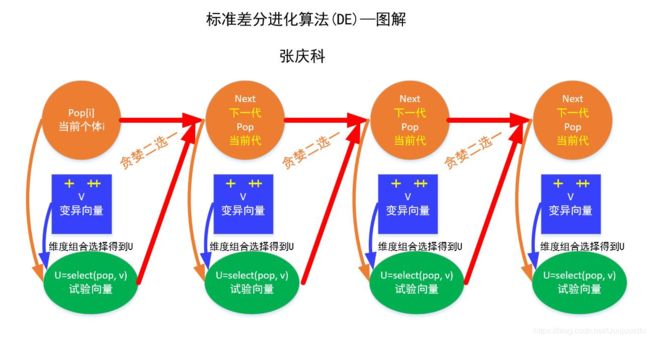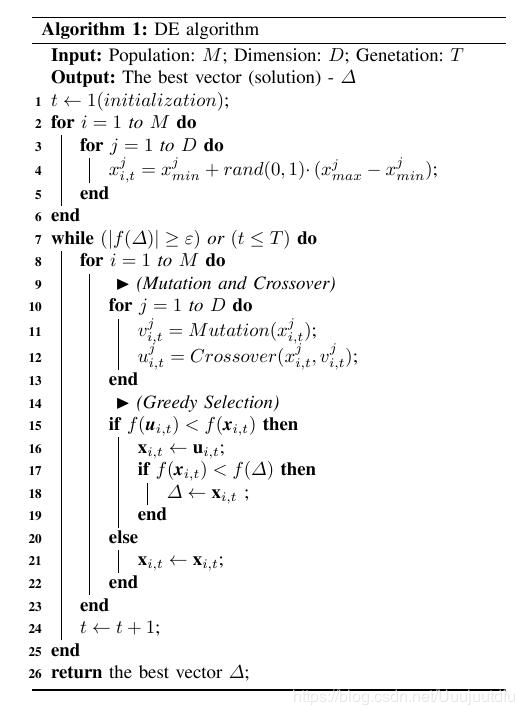【转载】差分进化算法 (Differential Evolution)
原文:https://www.cnblogs.com/tsingke/p/5809453.html
Differential Evolution(DE)是由Storn等人于1995年提出的,和其它演化算法一样,DE是一种模拟生物进化的随机模型,通过反复迭代,使得那些适应环境的个体被保存了下来。但相比于进化算法,DE保留了基于种群的全局搜索策略,采用实数编码、基于差分的简单变异操作和一对一的竞争生存策略,降低了遗传操作的复杂性。同时,DE特有的记忆能力使其可以动态跟踪当前的搜索情况,以调整其搜索策略,具有较强的全局收敛能力和鲁棒性,且不需要借助问题的特征信息,适于求解一些利用常规的数学规划方法所无法求解的复杂环境中的优化问题。目前,DE已经在许多领域得到了应用,譬如人工神经元网络、化工、电力、机械设计、机器人、信号处理、生物信息、经济学、现代农业、食品安全、环境保护和运筹学等。
DE算法-作者网站: http://www1.icsi.berkeley.edu/~storn/code.html
维基百科资料库 : https://en.wikipedia.org/wiki/Differential_evolution
DE 算法主要用于求解连续变量的全局优化问题,其主要工作步骤与其他进化算法基本一致,主要包括变异(Mutation)、交叉(Crossover)、选择(Selection)三种操作。算法的基本思想是从某一随机产生的初始群体开始,利用从种群中随机选取的两个个体的差向量作为第三个个体的随机变化源,将差向量加权后按照一定的规则与第三个个体求和而产生变异个体,该操作称为变异。然后,变异个体与某个预先决定的目标个体进行参数混合,生成试验个体,这一过程称之为交叉。如果试验个体的适应度值优于目标个体的适应度值,则在下一代中试验个体取代目标个体,否则目标个体仍保存下来,该操作称为选择。在每一代的进化过程中,每一个体矢量作为目标个体一次,算法通过不断地迭代计算,保留优良个体,淘汰劣质个体,引导搜索过程向全局最优解逼近。
算法图解:

算法伪代码:
 算法C代码:
算法C代码:
1 ///
2 // DE/rand/1/bin --差分进化算法-(基本类型)
3 ///
4
5
6 #include
7 #include
8 #include
9 #include
10
11 /* Function definitions */
12
13 double func(double *);
14 int usage(char );
15
16 / Random number generator defined by URAND should return
17 double-precision floating-point values uniformly distributed
18 over the interval [0.0, 1.0) /
19
20 #define URAND ((double)rand()/((double)RAND_MAX + 1.0))
21
22 / Definition for random number generator initialization /
23
24 #define INITRAND srand(time(0))
25
26 / Usage for the program */
27
28 int usage(char str)
29 {
30 fprintf(stderr, "Usage: %s [-h] [-u] [-s] [-N NP (20D)] ", str);
31 fprintf(stderr, “[-G Gmax (1000)]\n”);
32 fprintf(stderr, “\t[-C crossover constant, CR (0.9)]\n”);
33 fprintf(stderr, “\t[-F mutation scaling factor, F (0.9)]\n”);
34 fprintf(stderr, “\t[-o ]\n\n”);
35 fprintf(stderr, “\t-s does not initialize random number generator\n”);
36 exit(-1);
37 }
38
39
40 int main(int argc, char **argv)
41 {
42 register int i, j, k, r1, r2, r3, jrand, numofFE = 0;
43 extern int D;
44 extern double Xl[], Xu[];
45
46 int NP = 20 * D, Gmax = 1000, c, index = -1, s = 1;
47
48 double **popul, **next, **ptr, *iptr, *U, CR = 0.9, F = 0.9,
49
50 min_value = DBL_MAX, totaltime = 0.0;
51
52 char *ofile = NULL;
53
54 FILE fid;
55 clock_t starttime, endtime;
56
57
58 / Parse command line arguments given by user /
59
60 for (i = 1; i < argc; i++)
61 {
62 if (argv[i][0] != ‘-’)
63 usage(argv[0]);
64
65 c = argv[i][1];
66
67 switch ©
68 {
69 case ‘N’:
70 if (++i >= argc)
71 usage(argv[0]);
72
73 NP = atoi(argv[i]);
74 break;
75 case ‘G’:
76 if (++i >= argc)
77 usage(argv[0]);
78
79 Gmax = atoi(argv[i]);
80 break;
81 case ‘C’:
82 if (++i >= argc)
83 usage(argv[0]);
84
85 CR = atof(argv[i]);
86 break;
87 case ‘F’:
88 if (++i >= argc)
89 usage(argv[0]);
90
91 F = atof(argv[i]);
92 break;
93 case ‘o’:
94 if (++i >= argc)
95 usage(argv[0]);
96
97 ofile = argv[i];
98 break;
99 case ‘s’: / Flag for using same seeds for /
100 s = 0; / different runs /
101 break;
102 case ‘h’:
103 case ‘u’:
104 default:
105 usage(argv[0]);
106 }
107 }
108
109 if (s) INITRAND;
110
111 / Printing out information about optimization process for the user /
112
113 printf("Program parameters: ");
114 printf(“NP = %d, Gmax = %d, CR = %.2f, F = %.2f\n”,
115 NP, Gmax, CR, F);
116
117 printf(“Dimension of the problem: %d\n”, D);
118
119
120 / Starting timer /
121
122 starttime = clock();
123
124
125 / Allocating memory for current and next populations, intializing
126 current population with uniformly distributed random values and
127 calculating value for the objective function /
128
129
130 // NP:种群大小, Gmax:迭代次数, CR:交叉概率, F:扰动向量的缩放因子
131
132 //当前种群
133 popul = (double **)malloc(NPsizeof(double ));
134 if (popul == NULL) perror(“malloc”);
135
136 //下代种群
137 next = (double **)malloc(NPsizeof(double *));
138 if (next == NULL) perror(“malloc”);
139
140 //当前种群popul[NP][D+1]
141 for (i = 0; i < NP; i++)
142 {
143 //个体维度空间分配
144 popul[i] = (double *)malloc((D + 1)sizeof(double));
145 if (popul[i] == NULL) perror(“malloc”);
146
147 //初始化维度值
148 for (j = 0; j < D; j++)
149 popul[i][j] = Xl[j] + (Xu[j] - Xl[j])URAND;
150
151 //最后的元素内存放该个体的适应度值
152 popul[i][D] = func(popul[i]);
153
154 numofFE++;//统计评估次数
155
156 //下一代个体空间分配
157 next[i] = (double )malloc((D + 1)sizeof(double));
158 if (next[i] == NULL) perror(“malloc”);
159 }
160
161 / 为实验向量分配空间–Allocating memory for a trial vector U /
162
163 U = (double )malloc((D + 1)sizeof(double));
164 if (U == NULL) perror(“malloc”);
165
166
167 / The main loop of the algorithm /
168
169 for (k = 0; k < Gmax; k++)
170 {
171
172 for (i = 0; i < NP; i++) / Going through whole population /
173 {
174
175 / Selecting random indeces r1, r2, and r3 to individuls of
176 the population such that i != r1 != r2 != r3 /
177
178 //1.选择三个互不相同的随机个体r1,r2,r3
179 do
180 {
181 r1 = (int)(NPURAND);
182 } while (r1 == i);
183
184 do
185 {
186 r2 = (int)(NPURAND);
187 } while (r2 == i || r2 == r1);
188 do
189 {
190 r3 = (int)(NPURAND);
191 } while (r3 == i || r3 == r1 || r3 == r2);
192
193 jrand = (int)(DURAND);
194
195 / Mutation and crossover /
196 //2. 执行变异和交叉操作
197 for (j = 0; j < D; j++)
198 {
199 //执行二项式交叉
200 if (URAND < CR || j == jrand)
201 {
202 //试验向量部分来自变异后的向量
203 U[j] = popul[r3][j] + F(popul[r1][j] - popul[r2][j]);
204 }
205 else
206 //试验向量部分来自个体i
207 U[j] = popul[i][j];
208 }
209 //3. 计算新生成向量的适应度值
210 U[D] = func(U);
211
212 numofFE++;
213
214 / Comparing the trial vector ‘U’ and the old individual
215 ‘next[i]’ and selecting better one to continue in the
216 next population.注意:空间的交替变换和使用 /
217
218 //贪婪策略从试验向量U和当前个体i中选择一个好的放入到下一代个体中
219 if (U[D] <= popul[i][D])//新向量好
220 {
221
222 //试验向量U牛逼, next指向当前的试验向量U,u指向next, 方法:指针交换
223 iptr = U;
224 U = next[i];
225 next[i] = iptr;
226 }
227 else//原始向量牛逼, next指向个体i, 方法: 直接拷贝
228 {
229 for (j = 0; j <= D; j++)
230 next[i][j] = popul[i][j];
231 }
232
233 } / End of the going through whole population /
234
235
236 / Pointers of old and new populations are swapped /
237 //指针交换,各指针指向的空间发生变化
238 ptr = popul;
239 popul = next;
240 next = ptr;
241
242 } / End of the main loop /
243
244
245 / Stopping timer /
246
247 endtime = clock();
248 totaltime = (double)(endtime - starttime);
249
250
251 / If user has defined output file, the whole final population is
252 saved to the file */
253
254 if (ofile != NULL)
255 {
256 if ((fid = (FILE )fopen(ofile, “a”)) == NULL)
257 {
258 fprintf(stderr, “Error in opening file %s\n\n”, ofile);
259 usage(argv[0]);
260 }
261
262 for (i = 0; i < NP; i++)
263 {
264 for (j = 0; j <= D; j++)
265 fprintf(fid, "%.15e ", popul[i][j]);
266 fprintf(fid, “\n”);
267 }
268 fclose(fid);
269 }
270
271 / Finding best individual /
272
273 for (i = 0; i < NP; i++)
274 {
275 if (popul[i][D] < min_value)
276 {
277 min_value = popul[i][D];
278 index = i;
279 }
280 }
281
282 / Printing out information about optimization process for the user /
283
284 printf(“Execution time: %.3f s\n”, totaltime / (double)CLOCKS_PER_SEC);
285 printf(“Number of objective function evaluations: %d\n”, numofFE);
286
287 printf(“Solution:\nValues of variables: “);
288 for (i = 0; i < D; i++)
289 printf(”%.15f “, popul[index][i]);
290
291 printf(”\nObjective function value: “);
292 printf(”%.15f\n”, popul[index][D]);
293
294
295 / Freeing dynamically allocated memory */
296
297 for (i = 0; i < NP; i++)
298 {
299 free(popul[i]);
300 free(next[i]);
301 }
302 free(popul);
303 free(next);
304 free(U);
305
306 return(0);
307 }
复制代码
经典文献:
[1] Storn, R., "Designing Nonstandard Filters with Differential Evolution, IEEE Signal Processing Magazine, january 2005, pp. 103 - 106.
[2] Storn, R., “Sytem Design by Constraint Adaptation and Differential Evolution”, IEEE Trans. on Evolutionary Computation, 1999, Vol. 3, No. 1, pp. 22 - 34.
[3] Storn, R. and Price, K., “Differential Evolution - a Simple and Efficient Heuristic for Global Optimization over Continuous Spaces”, Journal of Global Optimization, Kluwer Academic Publishers, 1997, Vol. 11, pp. 341 - 359.
[4] Gitsels, M. and Storn, R., Internet-Videotelephonie nach dem H.323-Standard, ITG-Fachbericht 144, 7. Dortmunder Fernsehseminar, pp. 87 - 92.
[5] Storn, R., “Echo Cancellation Techniques for Multimedia Applications - A Survey” , Technical Report TR-96-046, ICSI, November 1996, ftp.icsi.berkeley.edu.
[6] Storn, R., “System Design by Constraint Adaptation and Differential Evolution” , Technical Report TR-96-039, ICSI, November 1996, ftp.icsi.berkeley.edu.
[7] Price, K. and Storn, R., “Differential Evolution: Numerical Optimization Made Easy”, Dr. Dobb’s Journal, April 97, pp. 18 - 24.
[8] Storn, R., “On the Usage of Differential Evolution for Function Optimization” NAFIPS 1996, Berkeley, pp. 519 - 523.
[9] Storn, R. and Price, K., “Minimizing the real functions of the ICEC’96 contest by Differential Evolution” IEEE Conference on Evolutionary Computation, Nagoya, 1996, pp. 842 - 844.
[10] Storn, R., “Efficient Input Reordering for the DCT Based on a Real-Valued Decimation in Time FFT” (IEEE Signal Processing Letters, Vol. 3, No. 8, August 1996, pp. 242 - 244), Technical Report TR-95-061, ICSI, September 1995, ftp.icsi.berkeley.edu.
[11] Storn, R., “Differential Evolution Design of an IIR-Filter with Requirements for Magnitude and Group Delay” IEEE International Conference on Evolutionary Computation ICEC 96, pp. 268 - 273, Technical Report TR-95-026, ICSI, May 1995, ftp.icsi.berkeley.edu.
[12] Storn, R., “Modeling and Optimization of PET-Redundancy Assignment for MPEG Sequences” , Technical Report TR-95-018, ICSI, May 1995, ftp.icsi.berkeley.edu.
[13] Storn, R. and Price, K., “Differential Evolution - a Simple and Efficient Adaptive Scheme for Global Optimization over Continuous Spaces” , Technical Report TR-95-012, ICSI, March 1995, ftp.icsi.berkeley.edu. Anyone who is interested in trying Differential Evolution (DE) might access the source code.
[14] Storn, R., “A Debug/Trace Tool for C SW Projects”, Dr. Dobb’s Journal, February 1997, pp. 22 - 26.
[15] Storn, R., “Constrained Optimization”, Dr. Dobb’s Journal, May 1995, pp. 119 - 123.
[16] Christ, J., Storn, R. and Lueder, E., " New Shortlength DFTs for the Prime Factor Implementation on DSP Architectures", Frequenz, 1995, Band 49, Issue 1-2, pp. 8 - 10.
[17] Ballay, H. and Storn, R., “A Tool for Checking C Coding Conventions”, C User’s Journal, july 94, pp. 41 - 50…
[18] Storn, R., “A Hashing Function Based on Algebraic Coding”, submitted for publication in the I.E.E. Proceedings~E, Computers and Digital Techniques.
[19] Storn, R., “A Radix-2 FFT-Pipeline Architecture With Reduced Noise to Signal Ratio”, I.E.E. Proceedings~F, Radar and Signal Processing, 1994.
[20] Storn, R. , “Datensicherung mit Prüfsummen”, ST-Computer, 1994.
[21] Storn, R., "Some Results in Fixed Point Error Analysis of the Bruun-FFT Algorithm, IEEE Trans. on Signal Processing, Vol. 41, No. 7, July 93, pp. 2371 - 2375.
[22] Storn, R. , “Statistische Optimierung”, ST-Computer, Issues 12/1992 and 1/1993.
[23] Storn, R. , “On the Bruun Algorithm and its Inverse”, Frequenz, Vol. 3-4, 1992, pp. 110 -116.
[24] Storn, R. , “Logische Schaltungen und deren Vereinfachung nach Quine-McCluskey”, ST-Computer, Issues 3, 4 and 5, 1990.
[25] Storn, R. , “A novel Radix-2 Pipeline Architecture for the Computation of the DFT”, IEEE Proc. of the ISCAS 1988, pp. 1899 -1902.
[26] Storn, R. , “On the Reduction of Arithmetic Complexity in the Chirp-Transform”, Proc. ECCTD, 1987, pp. 239 -244.
[27] Storn, R. , “Ein Primfaktor-Algorithmus für die diskrete Hartley-Transformation”, 9. DFG-Kolloquium über digitale Signalverarbeitung, 1986, pp. 79 -82.
[28] Storn, R. , “Fast Algorithms for the Discrete Hartley Transform”, AEÜ, Band 40, Heft 4, 1986, pp. 233 -240.
[29] Storn, R. , “Dreieck-Quadratur-Oszillator. Nur ein zeitbestimmendes Glied erforderlich”, Elektronik, Issue 5, 1982, p. 74.
[30] Storn, R. , “Constant Current Adapter”, Elektor, Issue 7/8, 1981.
[31] Storn, R. , “De Luxe Transistor Tester”, Elektor, Issue 7/8, 1979. (The corresponding circuit was among the winners of the european circuit design contest “EUROTRONIK”).
BOOKS
[1] Price K., Storn R., Lampinen J., Differential Evolution - A Practical Approach to Global Optimization, Springer, Berlin, 2005.
[2] Contributor for Babu, B.V., Onwubolu, G. (Editors), New Optimization Techniques in Engineering, Springer, Berlin, 2004.
[3] Contributor for Corne, D., Dorigo., M, and Glover., F. (Editors), New Ideas in Optimization, McGraw-Hill, 1999.目录标题)